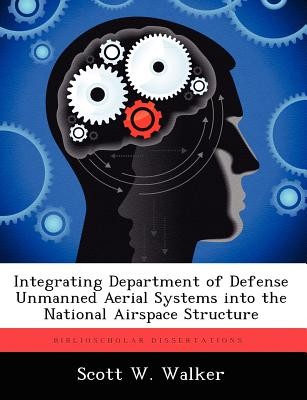
- We will send in 10–14 business days.
- Author: Scott W Walker
- Publisher: BiblioScholar
- ISBN-10: 1249369053
- ISBN-13: 9781249369059
- Format: 18.9 x 24.6 x 0.5 cm, softcover
- Language: English
- SAVE -10% with code: EXTRA
Integrating Department of Defense Unmanned Aerial Systems Into the National Airspace Structure (e-book) (used book) | bookbook.eu
Reviews
Description
The Department of Defense (DoD) is constantly adding to the inventory of unmanned aerial systems (UAS) across all Services. Compounded by increasing mission sets for unmanned aviation, both home and abroad, DoD requires the ability to operate UAS within and throughout the US national airspace structure (NAS). The Federal Aviation Administration (FAA) has the responsibility of managing, updating, and amending federal regulations for the safe operation of aerospace vehicles within the NAS. Based on safety concerns, the FAA currently limits UAS operations within the NAS through a certification of authorization process that takes up to 60 days for approval and limits flight profiles to specific parameters. While the DoD is not satisfied with this process, as it limits UAS operations within the US, the FAA will not amend current regulations until certain operating and design parameters are met. Based upon these two views, this thesis determines if the DoD and FAA are working together in an efficient manner to develop a safe way to integrate UAS into the NAS and provides recommendations for future integration. By granting the FAA the power to incorporate all facets of UAS processes, it can define terms and develop regulations for UAS integration. The FAA must also develop a UAS categorization system and start incorporating smaller UAS that lack full integration capability in order to concentrate on the larger issue of full NAS access. These recommendations provide a point of departure for the DoD and FAA to start integrating UAS into the NAS that will benefit operations in both the civil and public sector.
EXTRA 10 % discount with code: EXTRA
The promotion ends in 16d.16:20:34
The discount code is valid when purchasing from 10 €. Discounts do not stack.
- Author: Scott W Walker
- Publisher: BiblioScholar
- ISBN-10: 1249369053
- ISBN-13: 9781249369059
- Format: 18.9 x 24.6 x 0.5 cm, softcover
- Language: English English
The Department of Defense (DoD) is constantly adding to the inventory of unmanned aerial systems (UAS) across all Services. Compounded by increasing mission sets for unmanned aviation, both home and abroad, DoD requires the ability to operate UAS within and throughout the US national airspace structure (NAS). The Federal Aviation Administration (FAA) has the responsibility of managing, updating, and amending federal regulations for the safe operation of aerospace vehicles within the NAS. Based on safety concerns, the FAA currently limits UAS operations within the NAS through a certification of authorization process that takes up to 60 days for approval and limits flight profiles to specific parameters. While the DoD is not satisfied with this process, as it limits UAS operations within the US, the FAA will not amend current regulations until certain operating and design parameters are met. Based upon these two views, this thesis determines if the DoD and FAA are working together in an efficient manner to develop a safe way to integrate UAS into the NAS and provides recommendations for future integration. By granting the FAA the power to incorporate all facets of UAS processes, it can define terms and develop regulations for UAS integration. The FAA must also develop a UAS categorization system and start incorporating smaller UAS that lack full integration capability in order to concentrate on the larger issue of full NAS access. These recommendations provide a point of departure for the DoD and FAA to start integrating UAS into the NAS that will benefit operations in both the civil and public sector.


Reviews